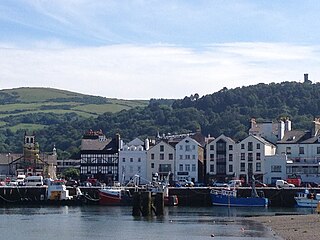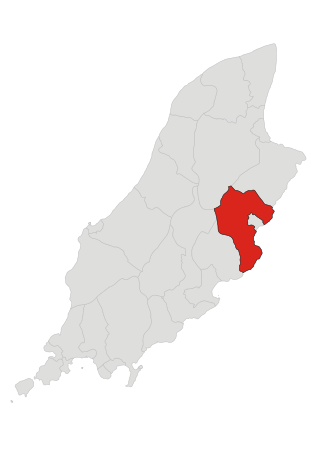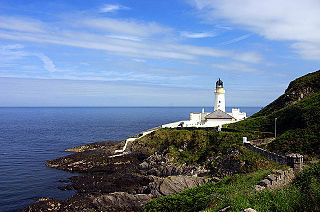Related Research Articles

The Isle of Man is an island in the Irish Sea, between Great Britain and Ireland in Northern Europe, with a population of almost 85,000. It is a British Crown dependency. It has a small islet, the Calf of Man, to its south. It is located at 54°15′N4°30′W.
Protected areas of the United Kingdom are areas in the United Kingdom which need and /or receive protection because of their environmental, historical or cultural value to the nation. Methods and aims of protection vary depending on the nature and importance of the resource. Protection operates at local, regional, national and international levels, and may be backed by legislation and international treaty, or less formally by planning policy.

Laxey is a village on the east coast of the Isle of Man. Its name derives from the Old Norse Laxa meaning 'Salmon River'. Its key distinguishing features are its three working vintage railways and the largest working waterwheel in the world. It is also the location of King Orry's Grave.

Ramsey is a coastal town in the north of the Isle of Man. It is the second largest town on the island after Douglas. Its population is 7,845 according to the 2016 Census. It has one of the biggest harbours on the island, and has a prominent derelict pier, called the Queen's Pier. It was formerly one of the main points of communication with Scotland. Ramsey has also been a route for several invasions by the Vikings and Scots.
Marine nature reserve (MNR) is a conservation designation officially awarded by a government to a marine reserve of national significance.

Ramsey Bay is a large bay and Marine Nature Reserve covering some 94 square kilometres off the northeastern coast of the Isle of Man. It runs for 18 kilometres from the Point of Ayre at the island's northern tip to Maughold Head. The port town of Ramsey, the island's second town, lies towards the south of the bay.

The Point of Ayre is the northernmost point of the Isle of Man. It lies at the northern end of Ramsey Bay 6 miles (10 km) north of the town of Ramsey. The point can be accessed by the A16 road from Bride. Point of Ayre lighthouse, the oldest lighthouse on the Isle of Man, is located here.

Lonan is one of the 17 parishes of the Isle of Man.

Douglas Head is a rocky point on the Isle of Man overlooking Douglas Bay and harbour. Views extend to include Snaefell Mountain and Laxey.
The Marine Parks Ordinance protects and conserves the marine environment and a rich collection of aquatic animals and plants, such as corals, sea grasses and dolphins. The ordinance also provides the legal framework for the designation, control and management of marine parks and marine reserves. The Marine Parks and Marine Reserve Regulation provides for the prohibition and control of certain activities in marine parks and marine reserve.
This is a list of the known wild biota of the Isle of Man.

Maerl is a collective name for non-geniculate coralline red algae with a certain growth habit. Maerl grows at a rate of c. 1 mm per year. It accumulates as unattached particles and forms extensive beds in suitable sublittoral sites. The term maerl originally refers to the branched growth form of Lemoine (1910) and rhodolith is a sedimentological or genetic term for both the nodular and branched growth forms.

The queen scallop is a medium-sized species of scallop, an edible marine bivalve mollusk in the family Pectinidae, the scallops. It is found in the northeast Atlantic and is important in fisheries.

There are about eight small places on the Isle of Man with the name Ballabeg. The name Ballabeg derives from the Manx Balley Beg which means small homestead; although the spelling is different, it is pronounced approximately the same as the English name.

Raad ny Foillan is a coastal long-distance footpath in the Isle of Man. Because it is a closed loop around the coast, it can be walked in either a clockwise or an anti-clockwise direction.

Skomer Marine Conservation Zone is an underwater marine nature reserve located off the coast of Pembrokeshire in Wales. The nature reserve completely surrounds the islands of Skomer and Middleholm, and encompasses the mainland coastline around the end of the Marloes peninsula, including the small bay of Martin's Haven.
Regionally important geological and geomorphological sites (RIGS) are locally designated sites of local, national and regional importance for geodiversity in the United Kingdom and Isle of Man. These sites are also known by other names, such as regionally important geological sites, Regionally Important Geodiversity Sites, County Geodiversity Sites in Norfolk, Local Geodiversity Sites in Scotland and Lancashire, and as County Geology Sites in Cornwall and Devon and in the Republic of Ireland.

Zostera marina is a flowering vascular plant species as one of many kinds of seagrass, with this species known primarily by the English name of eelgrass with seawrack much less used, and refers to the plant after breaking loose from the submerged wetland soil, and drifting free with ocean current and waves to a coast seashore. It is a saline soft-sediment submerged plant native to marine environments on the coastlines of northern latitudes from subtropical to subpolar regions of North America and Eurasia.

Baldrine is a village in the Isle of Man. It is close to the east coast of the island, about 3 km south of Laxey and 6 km NE of Douglas. It is in the historic parish of Lonan, in the sheading of Garff. For administrative purposes it is in the parish district of Garff, and it is also in the House of Keys constituency of Garff.
References
- 1 2 3 "Consultation on the designation of inshore Marine Nature Reserves" (PDF). consult.gov.im. Retrieved 18 May 2020.
- ↑ "MANX MARINE NATURE RESERVES (DESIGNATION) ORDER 2018" (PDF). www.tynwald.org.im. 2018. Retrieved 18 May 2020.
- ↑ "The New Isle of Man 0-3 nm Marine Nature Reserves" (PDF). www.gov.im. 2018. Retrieved 18 May 2020.
- ↑ "Isle of Man" (JPG). www.unesco.org.
- ↑ potential Regionally Important Geodiversity Sites
- ↑ Sea Fisheries Strategy